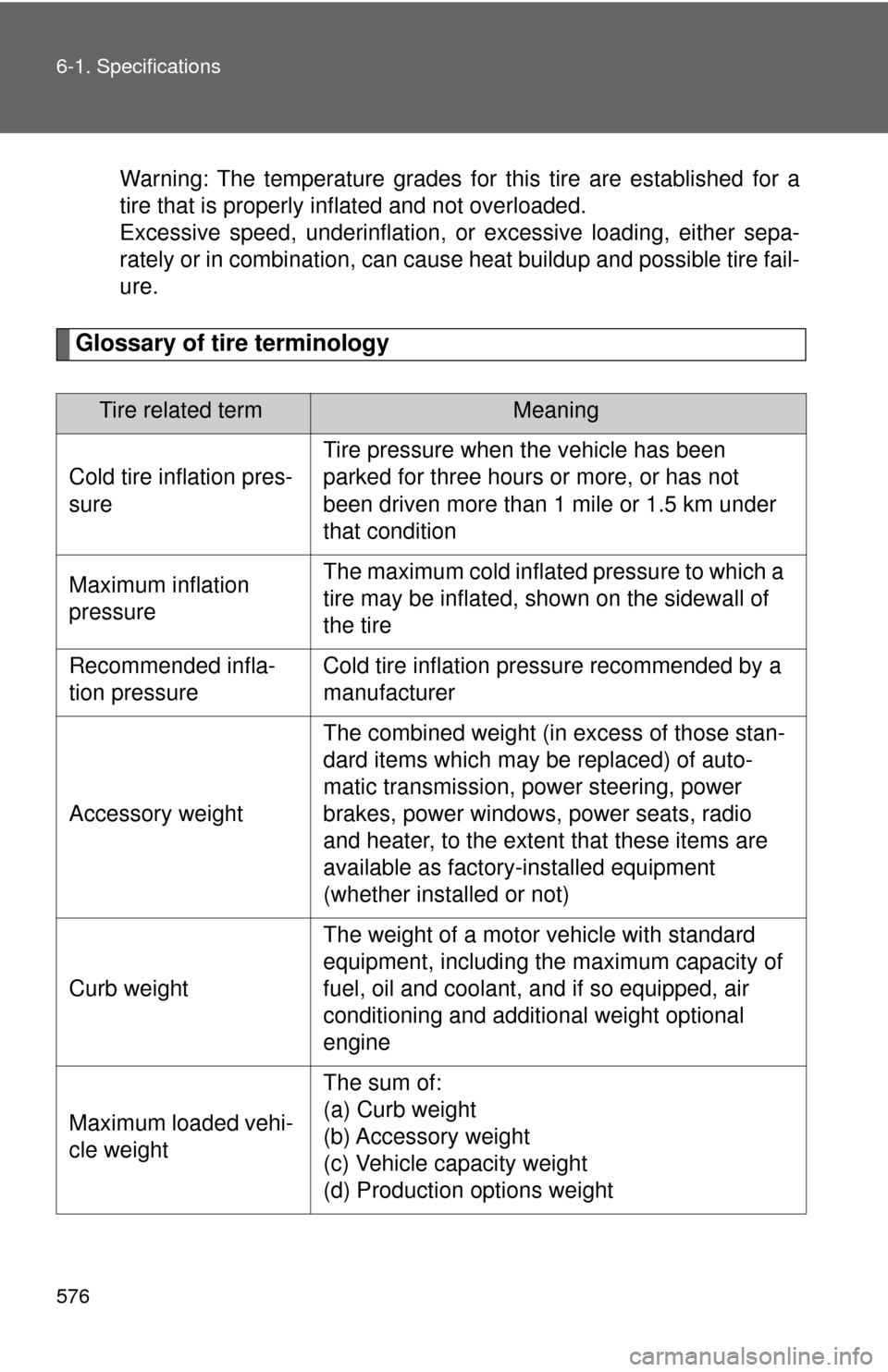Page 5 of 608

1
2
3
4
5
6
7
5
4-1. Maintenance and careCleaning and protecting the vehicle exterior............ 416
Cleaning and protecting the vehicle interior............. 419
4-2. Maintenance Maintenance requirements ..................... 422
General maintenance.......... 424
Emission inspection and maintenance (I/M)
programs........................... 427
4-3. Do-it-yourself maintenance Do-it-yourself service precautions ....................... 428
Hood ................................... 432
Positioning a floor jack ........ 434
Engine compartment ........... 437
Tires .................................... 453
Tire inflation pressure ......... 463
Wheels ................................ 467
Air conditioning filter............ 469
Wireless remote control/electronic key
battery ............................... 472
Checking and replacing fuses ................................. 475
Light bulbs........................... 486 5-1. Essential information
Emergency flashers............ 498
If your vehicle needs to be towed........................... 499
If you think something is wrong ............................ 506
Fuel pump shut off system .............................. 507
Event data recorder ............ 508
5-2. Steps to take in an emergency If a warning light turns on or a warning buzzer
sounds... .......................... 510
If a warning message is displayed (vehicles with
multi-information
display) ............................. 521
If you have a flat tire ........... 522
If the engine will not start.... 535
If the shift lever cannot be shifted from P ................... 537
If you lose your keys/wireless remote
control transmitter ............ 538
If the electronic key does not operate properly
(vehicles with smart
key system) ...................... 539
If the battery is discharged........................ 541
If your vehicle overheats .... 545
If the vehicle becomes stuck ................................. 548
4Maintenance and care5When trouble arises
Page 9 of 608
9
Tires
●Rotation
● Replacement
● Inflation pressure
● Information
P. 453
P. 522
P. 562
P. 570
∗: If equipped
Back door P. 71
Side doors P. 66
Tail and side marker
lights
P. 203
Rear window wiper P. 210
Rear window defogger
Glass hatch ∗
P. 277
P. 77
License plate lights P. 203
Rear turn signal lights P. 185
Fuel filler door P. 111
Page 416 of 608

416
4-1. Maintenance and care
Cleaning and protecting the vehicle exterior
■Automatic car washes
●Before washing the vehicle, do the following.
• Fold the mirrors back.
• Remove the antenna. (mast type only)
• Turn the power back door system off.
● Brushes used in automatic car washes may scratch the vehicle surface
and harm your vehicle’s paint.
■ High pressure car washes
●Do not allow the nozzles of the car wash to come within close proximity
of the windows.
● Before car wash, check that the fuel filler door on your vehicle is closed
properly.
Perform the following to protect the vehicle and maintain it in prime
condition.
● Working from top to bottom, liber ally apply water to the vehicle
body, wheel wells and underside of the vehicle to remove any
dirt and dust.
Wash the vehicle body using a sponge or soft cloth, such as a
chamois.
● For hard-to-remove marks, use car wash soap and rinse thor-
oughly with water.
● Wipe away any water.
● Wax the vehicle when the waterproof coating deteriorates.
If water does not bead on a clean surface, apply wax when the vehicle
body is cool.
Page 465 of 608

465
4-3. Do-it-yourself maintenance
4
Maintenance and care
■Effects of incorrect tire inflation pressure
Driving with incorrect ti
re inflation pressure ma y result in the following:
●Reduced fuel efficiency
●Reduced driving comfort and tire life
●Reduced safety
●Damage to the drive train
If a tire needs frequent re filling, have it checked by your Toyota dealer.
■Instructions for checking tire inflation pressure
When checking tire inflation pressure, observe the following:
●Check only when the tires are cold.
If your vehicle has been parked for at least 3 hours and has not been
driven for more than 1 mile or 1.5 km, you will get an accurate cold
tire inflation pressure reading.
●Always use a tire pressure gauge.
The appearance of the tire can be mi sleading. In addition, tire infla-
tion pressures that are even just a few pounds off can degrade ride
and handling.
●Do not bleed or reduce tire inflation pressure after driving. It is normal
for the tire inflation pressure to be higher after driving.
●Never exceed the vehicle capacity weight.
Passengers and luggage weight should be placed so that the vehicle
is balanced.
Page 483 of 608

483
4-3. Do-it-yourself maintenance
4
Maintenance and care
11 RR FOG
7.5 A No circuit
12 A/C NO.1 10 A Air conditioning system
13 FUEL OPN 7.5 A No circuit
14 S/ROOF 30 A Electric moon roof
15 TAIL 15 AParking lights, tail lights, license
plate lights, front fog lights, trailer
lights
16 PANEL 7.5 AGlove box light, emergency flash-
ers, audio system, outside rear
view mirror defoggers, clock, power
door lock system, seat heaters,
rear seat entertainment system,
enhanced vehicle stability control
system, instrument panel light con-
trol dial, electronic controlled trans-
mission switch, automatic
transmission, downhill assist con-
trol system, steering switches
17 ECU IG NO.1 10 A Multiplex communication system,
electric moon roof, electronically
controlled automatic transmission
system, power back door, seat
heaters, tire pressure warning sys-
tem, electronic power steering,
automatic transmission
18 ECU IG NO.2 7.5 A Enhanced vehicle stability control
system
19 A/C NO.2 10 A Air conditioning system
20 WASH 20 A Windshield wipers and washer
21 S-HTR 20 A Seat heaters
FuseAmpereCircuit
Page 519 of 608

5
When trouble arises
519
5-2. Steps to take in an emergency
CAUTION
■If the tire pressure warning light comes on
Be sure to observe the following precautions. Failure to do so could
cause loss of vehicle control and result in death or serious injury.
●Stop your vehicle in a safe place
as soon as possible. Adjust the tire
inflation pressure immediately.
●If the tire pressure warning light comes on even after tire inflation pres-
sure adjustment, it is pr obable that you have a flat tire. Check the tires.
If the tire is flat, change to the spar e tire and have the flat tire repaired
by the nearest Toyota dealer.
●Avoid abrupt maneuvering and braking. If the vehicle tires deteriorate,
you could lose control of the steering wheel or the brakes.
■If a blowout or sudden air leakage should occur
The tire pressure warning syste m may not activate immediately.
■Maintenance of the tires
Each tire, including the spare (if provided), should be checked monthly
when cold and inflated to the inflation pressure recommended by the
vehicle manufacturer on the vehicle placard or tire inflation pressure
label (tire and load information label). (If your vehicle has tires of a differ-
ent size than the size indicated on the vehicle placard or tire inflation
pressure label [tire and load information label], you should determine the
proper tire inflation pr essure for those tires.)
As an added safety feature, your vehicle has been equipped with a tire
pressure monitoring system (TPMS-ti re pressure warning system) that
illuminates a low tire pressure telltal e (tire pressure warning light) when
one or more of your tires is sign ificantly under-inflated. Accordingly,
when the low tire pressu re telltale (tire pressure warning light) illumi-
nates, you should stop and check your tires as soon as possible, and
inflate them to the proper pressure. Driving on a significantly under-
inflated tire causes the tire to overheat and can lead to tire failure.
Under-inflation also reduces fuel effi ciency and tire tread life, and may
affect the vehicle's handling and stopping ability.
Page 576 of 608

576 6-1. Specifications
Warning: The temperature grades for this tire are established for a
tire that is properly inflated and not overloaded.
Excessive speed, underinflation, or excessive loading, either sepa-
rately or in combination, can cause heat buildup and possible tire fail-
ure.
Glossary of tire terminology
Tire related termMeaning
Cold tire inflation pres-
sure Tire pressure when the vehicle has been
parked for three hours or more, or has not
been driven more than 1 mile or 1.5 km under
that condition
Maximum inflation
pressure The maximum cold inflated
pressure to which a
tire may be inflated, s hown on the sidewall of
the tire
Recommended infla-
tion pressure Cold tire inflation pressure recommended by a
manufacturer
Accessory weight The combined weight (in excess of those stan-
dard items which may be replaced) of auto-
matic transmission, power steering, power
brakes, power windows, power seats, radio
and heater, to the extent that these items are
available as factory-installed equipment
(whether installed or not)
Curb weight The weight of a motor vehicle with standard
equipment, including the maximum capacity of
fuel, oil and coolant, and if so equipped, air
conditioning and additional weight optional
engine
Maximum loaded vehi-
cle weight The sum of:
(a) Curb weight
(b) Accessory weight
(c) Vehicle capacity weight
(d) Production options weight
Page 606 of 608
606 What to do if...
A warning light or indicator light
comes onP. 510If a warning light turns on or a
warning buzzer sounds...
■Warning lights
P. 513
or
P. 5 1 0P. 513
P. 5 1 1
or
P. 5 1 1P. 513
P. 513
or
P. 5 1 1P. 513
P. 5 1 1P. 513
P. 5 1 3
Brake system warning
lightLow fuel level warning
light
Driver’s seat belt
reminder light
Charging system warn-
ing lightFront passenger’s seat belt
reminder light
Low engine oil pressure
warning light
Malfunction indicator
lampMaster warning light
Engine oil replacement
reminder light
SRS warning lightLow washer fluid warn-
ing light
Open door warning light